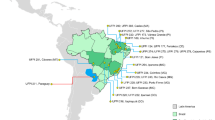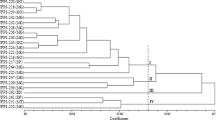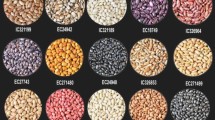Abstract
The value of intra- and interracial populations in common bean (Phaseolus vulgaris L.) needs to be determined in order to create useful genetic variation for maximizing gains from selection, broadening the genetic base of commercial cultivars, and making efficient use of available resources. Five large-seeded parents of race Nueva Granada (N), two small-seeded race Mesoamerica (M), and one medium-seeded race Durango (D) were hybridized to produce one intraracial (N x N) and three interracial (two N x M and one N x D) populations. Seventy-nine F2-derived F6 lines randomly taken from each population along with their parents were evaluated for agronomic traits and markers at Palmira and Popayán, Colombia, in 1990 and 1991. Variation for agronomic traits and for morphological, protein, and isozyme markers was larger in interracial populations than in the intraracial population. Mean seed yield of all lines as well as yield of the highest yielding line from two interracial populations were significantly higher than that of the intraracial population. The highest (≥ 0.80±0.15) heritability was recorded for 100-seed weight. Values for seed yield varied from 0.19±0.17 to 0.50±0.16. Gains from selection (at 20% selection pressure) for seed yield ranged from 3.9% to 11.4%. Seed yield was positively associated with biomass yield, pods/m2, and days to maturity, but harvest index showed negative correlations with these traits and a positive value with 100-seed weight. Polymorphism was recorded for phaseolin, lectins, protein Group-1 and protein Group-2 fractions, and six isozyme loci. Lines with indeterminate growth habit had significantly (P < 0.01) higher seed yield than lines with determinate growth habit in a Redkloud x MAM 4 population. Also, 23 other associations of markers with agronomic traits other than seed yield were recorded. Of these associations, lines with T phaseolin, the Diap1 2 allele, and lilac flower color tended to possess greater seed weight.
Similar content being viewed by others

References
Beaver JS, Kelly JD (1994) Comparison of selection methods for dry bean populations derived from crosses between gene pools. Crop Sci 34:34–37
Brown JWS, Bliss FA, Hall TC (1981 a) Linkage relationships between genes controlling seed proteins in French beans. Theor Appl Genet 60:251–259
Brown JWS, Ma Y, Bliss FA, Hall TC (1981 b) Genetic variation in the subunits of globulin-1 storage protein of French bean. Theor Appl Genet 59:83–88
Frey KJ, Horner T (1957) Heritability in standard units. Agron J 49:59–62
Gepts P, Bliss FA (1985) F1 hybrid weakness in the common bean: differential geographic origin suggests two gene pools in cultivated bean germplasm. J Hered 76:447–450
Gepts P, Osborn TC, Rashka K, Bliss FA (1986) Phaseolin-protein variability in wild forms and landraces of the common bean (Phaseolus vulgaris): evidence for multiple centers of domestication. Econ Bot 40:451–468
Hallauer A, Miranda J (1981) Quantitative genetics in maize breeding, 1st edn. Iowa State University Press, Ames, Iowa
Hussain A, Ramírez H, Roca W (1986) Manual práctico para la detección electroforética de isoenzimas y otras proteínas. Documento de Trabajo/Working Document No. 19, Centro Internacional de Agricultura Tropical (CIAT), Cali, Colombia
Khairallah MM, Adams MW, Sears BB (1990) Mitochondrial DNA polymorphisms of Malawian bean lines: further evidence for two major gene pools. Theor Appl Genet 80:753–761
Koenig RL, Gepts P (1989 a) Allozyme diversity in wild Phaseolus vulgaris: further evidence for two major centres of genetic diversity. Theor Appl Genet 78:809–817
Koenig RL, Gepts P (1989 b) Segregation and linkage of genes for seed proteins, isozymes, and morphological traits in common beans (Phaseolus vulgaris). J Hered 80:455–459
McIntosh MS (1983) Analysis of combined experiments. Agron J 75:153–155.
Motto M, Soressi GP, Salamini F (1978) Seed size inheritance in a cross between wild and cultivated common beans (Phaseolus vulgaris L.). Genetica 49:31–36
Nienhuis J, Singh SP (1986) Combining ability analysis and relationships among yield, yield components, and architectural traits in dry bean. Crop Sci 26:21–27
Nienhuis J, Singh SP (1988 a) Genetics of seed yield and its components in common bean (Phaseolus vulgaris L.) of Middle-American origin. I. General combining ability. Plant Breed 101:143–154
Nienhuis J, Singh SP (1988 b) Genetics of seed yield and its components in common bean (Phaseolus vulgaris L.) of Middle-American origin. II. Genetic variance, heritability and expected response from selection. Plant Breed 101:155:163
Shii C, Rabakoarihanta A, Mok M, Mok D (1982) Embryo development in reciprocal crosses of Phaseolus vulgaris L. and P. coccineus Lam. Theor Appl Genet 62:59–64
Singh SP (1982) A key for identification of different growth habits of Phaseolus vulgaris L. Annu Rep Bean Improv Coop 25:92–95
Singh SP (1989) Patterns of variation in cultivated common bean (Phaseolus vulgaris, Fabaceae). Econ Bot 43:39–57
Singh SP, Gutiérrez JA (1984) Geographical distribution of the DL 1 and DL 2 genes causing hybrid dwarfism in Phaseolus vulgaris L., their association with seed size, and their significance to breeding. Euphytica 33:337–345
Singh SP, Urrea CA (1994) Selection for seed yield and other traits among early generations of inter- and intraracial populations of the common bean. Rev Brasil Genet 17:299–303
Singh SP, Gepts P, Debouck DG (1991 a) Races of common bean (Phaseolus vulgaris, Fabaceae). Econ Bot 45:379–396
Singh SP, Gutiérrez J, Molina A, Urrea C, Gepts P (1991 b) Genetic diversity in cultivated common bean. II. Marker-based analysis of morphological and agronomic traits. Crop Sci 31:23–29
Singh SP, Nodari R, Gepts P (1991 c) Genetic diversity in cultivated common bean. I. Allozymes. Crop Sci 31:19–23
Singh SP, Terán H, Molina A, Gutiérrez JA (1991 d) Genetics of seed yield and its components in common beans (Phaseolus vulgaris L.) of Andean origin. Plant Breed 107:254–257
Singh SP, Teran H, Molina A, Gutiérrez J (1992 a) Combining ability for seed yield and its components in common bean of Andean origin. Crop Sci 32:81–84
Singh SP, Urrea CA, Molina A, Gutiérrez JA (1992 b) Performance of small-seeded common bean from the second selection cycle and multiple-cross intra- and interracial populations. Can J Plant Sci 72:735–741
Singh SP, Molina A, Urrea CA, Gutiérrez JA (1993) Use of interracial hybridization in breeding the race Durango common bean. Can J Plant Sci 73:785–793
Sprecher S (1988) Allozyme differentiation between genepools in common bean (Phaseolus vulgaris L.) with special reference to Malawi germplasm. PhD thesis, Michigan State University, Green Bay, Michigan
Steel RGD, Torrie JH (1960) Principles and procedures of statistics. McGraw-Hill Book Co, New York
White J, González A (1990) Characterization of the negative association between seed yield and seed size among genotypes of common bean. Field Crops Res 23:159–175
White J, Singh SP, Pino C, Rios M, Buddenhagen I (1992) Effects of seed size and photoperiod response on crop growth and yield of common bean. Field Crops Res 28:295–307
Author information
Authors and Affiliations
Additional information
Communicated by A. L. Kahler
Rights and permissions
About this article
Cite this article
Welsh, W., Bushuk, W., Roca, W. et al. Characterization of agronomic traits and markers of recombinant inbred lines from intra- and interracial populations of Phaseolus vulgaris L.. Theoret. Appl. Genetics 91, 169–177 (1995). https://doi.org/10.1007/BF00220874
Received:
Accepted:
Issue Date:
DOI: https://doi.org/10.1007/BF00220874



